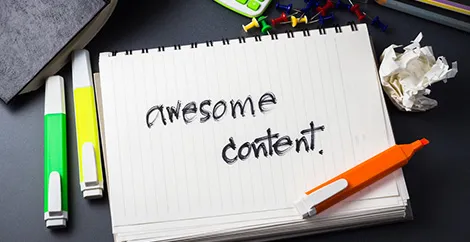In this third part of our IB Presentations series we’re going to discuss the art and science of choosing the best content for your presentation. Then, it’s all about keeping things clear. We’re going to look at how a good presentation is structured and the logic of good communication.
If this is the first post you’re reading in this miniseries, I’d advise you to go back and read the previous two and then come back to this one:
Part one – What you need to do and why you need to do it
Part two – Preliminary research and time management

Including Awesome Content
When it comes to your presentation, you might at first think ‘how the hell am I going to fill 2 / 3 / 5 minutes with speaking?!’. You will probably later realise that the big challenge is not finding things to say, but cutting down on content so that everything fits in the time allotted. The secret to good content is knowing what not to say. So how do you choose what you should talk about?
- Don’t repeat: Your content should not repeat things that your class already knows. There is no point in wasting time explaining what titration is to your chemistry class. Only teach people new things!
- Use a lot of examples. Examples are how people understand things. It’s all find to be talking about a theory in philosophy, but try talking about how it would apply in the real world and suddenly you’ll see your class is really interesting in what you have to say. BONUS: Use examples that are relevant to your audience. If you’re talking about the use of tools and technology you don’t have to discuss the biro and locomotive (or train to you and me). Why not discuss Siri and jet powered cars? They’re much more fun to your audience.
- Tell your audience what you chose not to include. Your history teacher will appreciate it if you explain that you didn’t have time to cover a certain historical event…but that you would like to have done so.
- Give ‘further reading’. At the end of your presentation you might want to advise your audience of where they can find out more about the topic you’ve been discussing. This could be as simple as directing them to the relevant textbook pages or it could be as extensive as providing an ‘additional reading’ list on a handout. This is bound to impress your teacher!
- Always remember that you are trying to make a point, and that anything that doesn’t contribute to making that point isn’t really necessary.
Don’t Panic:
You shouldn’t feel overwhelmed by the amount of things you can say in a presentation. There’s always more to say than there is time to speak. Follow the rules above and you should be fine. But…it’s not just about the content you include. The order in which you choose to present content is vital to how well you communicate.
Creating Logical Progress
Any time you do a presentation in the IB, whether for science the arts or languages, your teacher / peers will be thinking about the order of the material you present. If your presentation is clear and structured it will be useful and entertaining. If it is disorganised your work will be confusing and of little value. Let’s make sure your work is of the former kind.
A clear structure is the thread that leads your audience on a journey through the woods. This thread will take them to many places, some familiar, others less. But no matter where you take your audience if your structure is clear they will hang on to that thread and never feel lost.
This is what you have to do to create a really clear, logical IB presentation:
- Divide your presentation into sections / key ideas
- Introduce the overall theme of the presentation: Is this about WWII history or Spanish Poetry?
- Explain to your audience how each of your key ideas will relate back to the overall theme and teach them something useful!
- If you’re teaching a concept, such as in your science projects, explain what your audience should know by the end of the class. Your teacher probably does this in class all the time with ‘learning outcomes’ – you’re going to do the same.
- Go through each key idea. After explaining each idea link it back to the theme of the presentation.
- Finally, go through each idea you have talked about and explain how each taught the class something new about the topic. This is your conclusion.
- Optional: Talk about future issues. This isn’t that relevant if you’re dissecting a play in English. However, if you’re talking about an issue in science or ToK, your teacher will be super impressed if you can talk about what future research would help develop this topic better.
If you follow these rules your IB presentation will be interesting and extremely clear. Your class, your friends and your teacher will be entertained and feel that you have done a great job in your presentation. Well done!
Now your IB presentation is really coming together. Next week’s post will explain how to make an impact on your teacher / class and how to really get your point across to achieve those points. See you soon!
Read Part 4: Making your Point and Impressing your Audience!




